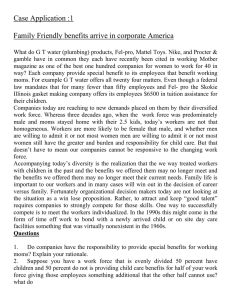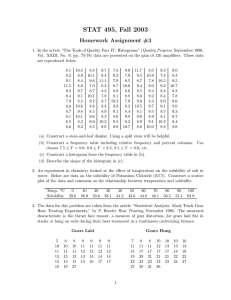Research Journal of Applied Sciences, Engineering and Technology 6(12): 2227-2232,... ISSN: 2040-7459; e-ISSN: 2040-7467
advertisement
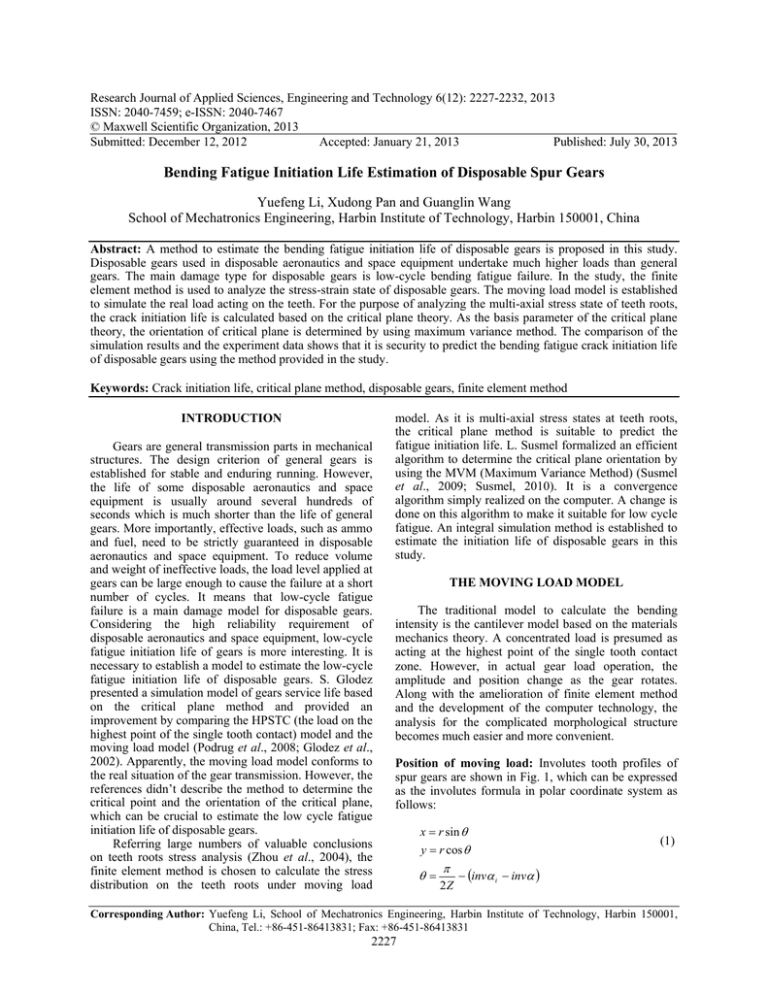
Research Journal of Applied Sciences, Engineering and Technology 6(12): 2227-2232, 2013 ISSN: 2040-7459; e-ISSN: 2040-7467 © Maxwell Scientific Organization, 2013 Submitted: December 12, 2012 Accepted: January 21, 2013 Published: July 30, 2013 Bending Fatigue Initiation Life Estimation of Disposable Spur Gears Yuefeng Li, Xudong Pan and Guanglin Wang School of Mechatronics Engineering, Harbin Institute of Technology, Harbin 150001, China Abstract: A method to estimate the bending fatigue initiation life of disposable gears is proposed in this study. Disposable gears used in disposable aeronautics and space equipment undertake much higher loads than general gears. The main damage type for disposable gears is low-cycle bending fatigue failure. In the study, the finite element method is used to analyze the stress-strain state of disposable gears. The moving load model is established to simulate the real load acting on the teeth. For the purpose of analyzing the multi-axial stress state of teeth roots, the crack initiation life is calculated based on the critical plane theory. As the basis parameter of the critical plane theory, the orientation of critical plane is determined by using maximum variance method. The comparison of the simulation results and the experiment data shows that it is security to predict the bending fatigue crack initiation life of disposable gears using the method provided in the study. Keywords: Crack initiation life, critical plane method, disposable gears, finite element method INTRODUCTION Gears are general transmission parts in mechanical structures. The design criterion of general gears is established for stable and enduring running. However, the life of some disposable aeronautics and space equipment is usually around several hundreds of seconds which is much shorter than the life of general gears. More importantly, effective loads, such as ammo and fuel, need to be strictly guaranteed in disposable aeronautics and space equipment. To reduce volume and weight of ineffective loads, the load level applied at gears can be large enough to cause the failure at a short number of cycles. It means that low-cycle fatigue failure is a main damage model for disposable gears. Considering the high reliability requirement of disposable aeronautics and space equipment, low-cycle fatigue initiation life of gears is more interesting. It is necessary to establish a model to estimate the low-cycle fatigue initiation life of disposable gears. S. Glodez presented a simulation model of gears service life based on the critical plane method and provided an improvement by comparing the HPSTC (the load on the highest point of the single tooth contact) model and the moving load model (Podrug et al., 2008; Glodez et al., 2002). Apparently, the moving load model conforms to the real situation of the gear transmission. However, the references didn’t describe the method to determine the critical point and the orientation of the critical plane, which can be crucial to estimate the low cycle fatigue initiation life of disposable gears. Referring large numbers of valuable conclusions on teeth roots stress analysis (Zhou et al., 2004), the finite element method is chosen to calculate the stress distribution on the teeth roots under moving load model. As it is multi-axial stress states at teeth roots, the critical plane method is suitable to predict the fatigue initiation life. L. Susmel formalized an efficient algorithm to determine the critical plane orientation by using the MVM (Maximum Variance Method) (Susmel et al., 2009; Susmel, 2010). It is a convergence algorithm simply realized on the computer. A change is done on this algorithm to make it suitable for low cycle fatigue. An integral simulation method is established to estimate the initiation life of disposable gears in this study. THE MOVING LOAD MODEL The traditional model to calculate the bending intensity is the cantilever model based on the materials mechanics theory. A concentrated load is presumed as acting at the highest point of the single tooth contact zone. However, in actual gear load operation, the amplitude and position change as the gear rotates. Along with the amelioration of finite element method and the development of the computer technology, the analysis for the complicated morphological structure becomes much easier and more convenient. Position of moving load: Involutes tooth profiles of spur gears are shown in Fig. 1, which can be expressed as the involutes formula in polar coordinate system as follows: x = r sin θ y = r cos θ θ= π 2Z (1) − (invα i − invα ) Corresponding Author: Yuefeng Li, School of Mechatronics Engineering, Harbin Institute of Technology, Harbin 150001, China, Tel.: +86-451-86413831; Fax: +86-451-86413831 2227 Res. J. Appl. Sci. Eng. Technol., 6(12): 2227-2232, 2013 Fig. 3: Load distribution factor Fig. 1: Involutes profile of spur gears Fig. 4: Schematic of B and C points position solving equal to parameter P, which is the function of the angular velocity ω and running time t. Fig. 2: Schematic of moving load model According to Eq. (1), the load F fixed at the HPSTC could be replaced by the moving load F (rsinωt, rcosωt) on the involutes profile. For simplifying the procedure, parameter P is defined as: r sin ωt P= = tan ωt r cos ωt (2) The position of moving load is the point on the involutes with the ratio of coordinate x to coordinate y Amplitude of moving load: As shown in Fig. 2, AB and CD are the multi teeth contact zones. BC is single tooth contact zone. To the different zones, numbers of contact teeth are different, which means that the amplitude of loads will be changed. As far as contact ratio ε is concerned, the load distribution is shown in Fig. 3. The load amplitude could be calculated in Eq. (3): FAmp = F ⋅ x Γ (3) The load sharing factor x Γ is present and taken from ISO standard. The positions of B and C points need to be determined to divide the contact zones. Eq. (4) is established in △N1OK shown in Fig. 4: 2228 Res. J. Appl. Sci. Eng. Technol., 6(12): 2227-2232, 2013 Procedure of moving load model: Based on the algorithm mentioned above, it is feasible to analyze stress state of teeth root by using finite element method. The procedure diagram is shown in Fig. 5. ORIENTATION OF THE CRITICAL PLANE The orientation of the critical plane at the critical point should be determined. The MVM (Susmel et al., 2009) depends on the load history damaging and could be used to solve the multi-axial fatigue problem. To describe the low cycle fatigue, Strain is used to calculate the maximum variance. It is assumed that fatigue damage proportional to the variance of the strain and the orientation of the critical plane coincides to the direction with the maximum shear strain variance. Main conclusions of the improved MVM based on strain are followed: The variance of γ’ f can be calculated in Eq. (9): Var[γ s (t )] = l T [V ]l (9) The matrix [V] in Eq. (10) could be written in form with variance and covariance terms: Fig. 5: Procedure diagram of the moving load model tan α = N1 A + AB + BK N1D − AD + AB + BK = rb1 rb1 N1D = rb1 tan α a1 Vx [V ] = C x, y C x , xy (4) AD = Pbε Vi = Var [ε i (t )] = The formula to calculate BK is followed: BK = Pb + rb1 (tan α − tan α a1 ) (5) rB = BK + OK − 2 BK ⋅ OK ⋅ cos(90° − α ) CK = BC − BK (6) ∫ [ε (t ) − ε ] dt T 0 2 i ,m i [ ] 1 = ∫ [ε (t ) − ε ] [ε (t ) − ε ]dt T T 0 i i,m j (11) j,m i = x,y,xy The strain state at the critical point is described by the following strain tensor: rc = KC + OK − 2 KC ⋅ OK ⋅ cos(90° + α ) ε x (t ) ε xy (t ) ε xy (t ) ε y (t ) (7) Applying Cosine theorem in △KOC, Eq. (8) is as follow: 2 1 T 2 BC = Pb (2 - ε ) 2 (10) Ci , j = CoVar ε i (t ), ε j (t ) Applying Cosine theorem in △BOK, Eq. (7) is obtained: 2 C x , xy C y , xy Vxy The variance and covariance of strain tensor can be calculated, respectively, as follows: AB = Pb (ε − 1) 2 C x, y Vy C y , xy [ε (t )] = Vector l shown in Fig. 6 is defined as follow: (8) In Eq. (7) and (8), the positions of B point can be solved. Using the same principle and procedure could obtain the position of C point. (12) l = [n x e x nyey ] n x e y + n y e x‘ (13) The vectors defining of orientation of axes n, a and e can be expressed as follows: 2229 Res. J. Appl. Sci. Eng. Technol., 6(12): 2227-2232, 2013 Table 1: Basic data of spur gears Module Number of teeth 0.5 50/50 Pressure angle 20° Outside diameter 26 Table 2: Nominal chemical composition of 14 NiCrMo 13-4 C Ni Cr 0.1% 3.22% 1.21% Table 3: Material parameters for 14 NiCrMo 13-4 b c τ’ f -0.099 -0.56 1761 Table 4: The principle value pre-calculated rB rC 43.9 45.7 Mo 0.12% γ’ f 0.08 Cu 0.13% σy 2000 A (2.96, 41.66) Whole depth 1.125 B (2.65, 43.83) Gear width 8 Mn 0.63% G 80000 C (2.01, 45.76) E 210000 Si 0.27% υ 0.3 D (1.16, 47.61) Fig. 6: Coordinate system on the material plane n x cos(φ ) n= = a= n y sin (φ ) ax sin (φ ) a = y − cos(φ ) ex cos(α ) cos(φ ) + sin (α ) sin (φ ) e= = ey cos(α ) sin (φ ) - sin (α ) cos(φ ) Fig. 7: The photos of the gear (14) The angle Φ is determined by the normal direction at the critical point. Then, the determination of the critical plane orientation becomes a maximum problem. RESULTS AND DISCUSSION Analyzed spur gears are made of high strength alloy steel 14 NiCrMo 13-4 with based data given in Table 1 (Podrug et al., 2008). The gear picture is shown in Fig. 7. The chemical composition and material parameters of 14 NiCrMo 13-4 materials are given in Table 2 (Handschuh and Krantz, 2007) and Table 3 (Podrug et al., 2008). Some parameters should be pre-calculated to determine the load sharing factor. Critical points A, B, C and D are boundaries to divide the contact zones. Coordinates of these points and radius from them to the gear center is given in Table 4. The infinite element model of the gear is shown in Fig. 8. Only the analyzed tooth and the adjacent teeth were meshed carefully for accelerating the running step. The whole model had 10789 elements and 11553 Fig. 8: Finite element model of the spur gear used in this study nodes. 4-node bilinear plane stress quadrilateral elements with reduced integration were used in the model. The analyzing step started from the tip of the tooth and finished at the end of the involutes profile. The whole analyzing time was defined as unit 1. According to Table 4, the time of the load activated on the points A, B, C, D, respectively, were 0, 0.42, 0.77 and 1. 2230 Res. J. Appl. Sci. Eng. Technol., 6(12): 2227-2232, 2013 Fig. 12: The gear fatigue test machine Pseudo stress (MPa) 3500 Fig. 9: Simulation results of the moving load model 1E-3 ε1 ε 12 6E-3 Experimental 2100 1400 700 2E-3 Strain 2800 Simulation -2E-3 0 1E0 -6E-3 1E1 1E3 1E2 1E4 1E5 Nf -1E-2 Fig. 13: Comparison of the simulation and experimental results 0 0.2 0.4 0.6 Time 0.8 1.0 Fig. 10: Strain tensor components at the critical point Fig. 11: The orientation of the critical plane at the critical point The analyzing results of the moving load are presented in Fig. 9. It could be seen from the pictures that Stress level is much higher than the yield strength of 14 NiCrMo 13-4. The reason why that happens is that concentrate force is added on the tooth profile. The simulation model only guarantees the moment added on gears. It is accurate enough to analyze the bending stress state of teeth roots but not for the contact stress on the surface of teeth, which is another design index of gears. This study focuses on the bending fatigue of teeth. Thus, it doesn’t mean mistakes. Strain tensor components at the critical point are shown in Fig. 10. The variance and covariance were calculated in Eq. (11). Then the orientation of the critical plane is determined by angle Φ and α together. As shown in Fig. 11, the orientation of critical plane is drawn to find the initiation value to find angle Φ and α with the maximum variance. After determining the critical plane orientation, the maximum principle stress on the critical plane can be used to estimate the crack initiation life of gears. An experiment was done to verify the calculation results. The gear fatigue test machine is shown in Fig. 12. Comparison of the simulation results and the experimental is shown in Fig. 13. In Fig. 13, “Pseudo stress” was defined in the reference (Handschuh and Krantz, 2007). Pseudo stress is proportional to moments added on gears. It generated as the liner elastic mechanics theory used in the simulation model. Only elastic properties were given to the material. If the plastic properties were given, surface stresses will lead to huge plastic deformations on teeth profiles. It will influence the teeth root stress state. CONCLUSION Disposable gears undertake much higher load level than general gears. Consequently, the low-cycle fatigue failure is the main damage type of disposable gears. This study presented a method to estimate the bending 2231 Res. J. Appl. Sci. Eng. Technol., 6(12): 2227-2232, 2013 fatigue initiation life of disposable gears. The moving load model was established and realized to simulate the real running situation. The critical plane theory was used to estimate the initiation life of disposable gears. The maximum variance method was used to determine the orientation of the critical plane. The comparison of the simulation results with the experiment data, the simulation model is security to estimate the initiation life of disposable gears. ABBREVIATION b c F = Shear fatigue strength exponent = Shear fatigue ductility exponent = Force on the highest point of single tooth contact zone F(x, y) = Moving load = Amplitude of moving load F Amp G = Shear modulus N 1 N 2 = Meshing zone in theories = Pitch on the base circle Pb (r, θ) = Polar coordinate of points on involutes r a1 r a2 = Addendum radius r b r b1 r b2 = Radius of base circle = Radius of points B and C rB rC t = Rotation time of gears = Load sharing factor xΓ = Pressure angle of point i αi α = Pressure angle of pitch circle α a1 α b1 = Pressure angle of addendum θ, Φ = Direction angles of vector l ε = Coincidence degree ω = Angular velocity Z Z 1 Z 2 = Numbers of teeth Ω = Angular velocity of gears = Shear fatigue strength coefficient τ’ f γ’ f σy = Shear fatigue ductility coefficient = Yield strength ACKNOWLEDGMENT This study was supported by the National Natural Science Foundation of China [grant number 51005051]. REFERENCES Glodez, S., M. Sraml and J. Kramberger, 2002. A simulation model for determination of service life of gears. Int. J. Fatigue, 24: 1013-1020. Handschuh, R.F. and T.L. Krantz, 2007. Investigation of low-cycle bending fatigue of AISI 9310 steel spur gears. Report for NASA. Report No. NASA/TM-2007-214914, ARL-TR-4100. Podrug, S., D. Jelaska and S. Glodez, 2008. Influence of different load models on gear crack path shapes and fatigue lives. Fatigue Fract. Eng. Mater. Struct., 31: 327-339. Susmel, L., 2010. A simple and efficient numerical algorithm to determine the orientation of the critical plane in multi-axial fatigue problems. Int. J. Fatigue, 32: 1875-1883. Susmel, L., R. Tovo and D. Benasciutti, 2009. A novel engineering method based on the critical plane concept to estimate the lifetime of weldments subjected to variable amplitude multi-axial fatigue loading. Fatigue Fract. Eng. Mater. Struct., 32: 441-459. Zhou, C.J., J.Y. Tang and Y.X. Wu, 2004. Progress and comparison study of simulation methods of teeth roots stress and elastic deformation. J. Mech. Trans., 5: 1-6, (In Chinese). 2232
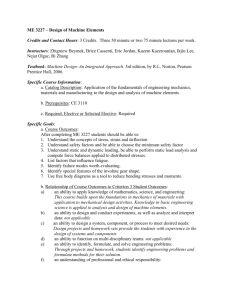

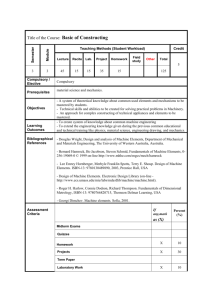
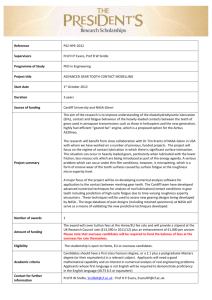
![Machine Elements [Opens in New Window]](http://s3.studylib.net/store/data/009054465_1-76bd66345967cd60934cd86eccae6fad-300x300.png)
